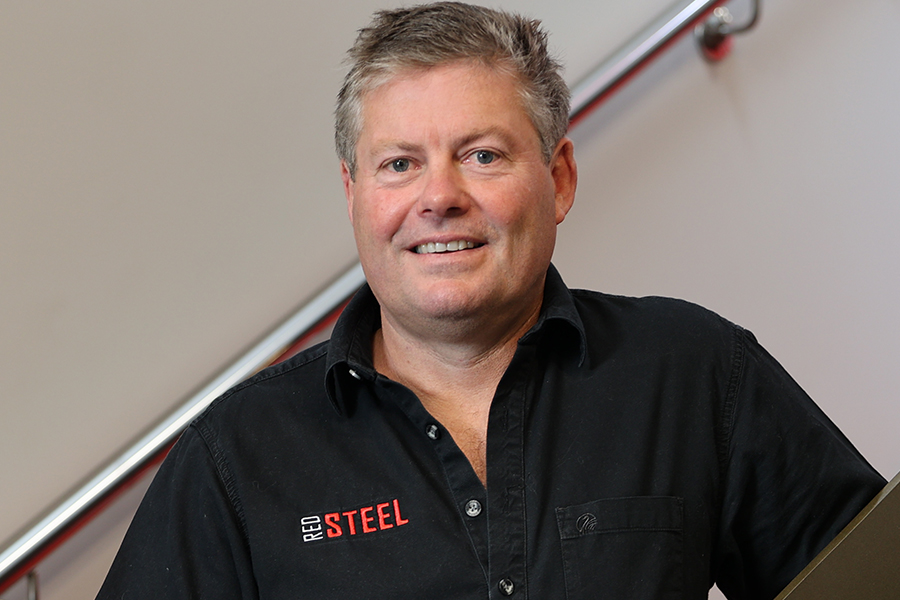Our next “Sixty seconds of steel’ feature is with Bob Hawley of Red Steel Limited.
Bob Hawley is the Managing Director at Red Steel, which laid its foundation in the 1960s as a building company specialising in steel construction. It was then officially formed in November 2002 before purchasing Woolaway Steel Structures in January 2003.
Red Steel specialises in structural steelwork and undertakes contracts predominantly in the lower North Island of New Zealand from its purpose-built facility in Pandora, Napier constructed in 2015.
How are you finding current business conditions?
Getting work is not an issue. The challenge going forward is the planning to ensure we have the resources required to fulfil our clients’ requirements.Often we are fabricating projects before they are needed because we have the time to fabricate it now, whereas we can see in two months’ time, for example, when a client might need the job, we haven’t got the fabrication capacity.
This goes against the ‘just in time’ manufacturing process but becomes necessary as construction programmes are constantly changing.
Also impacting are the other trades that have constraints with material supply – we might be on programme but the project gets delayed whereas another project hasn’t. It is a big juggling act.
How has your company been impacted by the pandemic?
The lockdowns had a large impact, but at the moment it is probably harder. With lockdowns all trades stop working and projects just start again from where they left off. Everyone is in the same boat.
At one point recently we were nearly a third of the staff down so our fabrication output was reduced but work continues on site and we are still expected to deliver as scheduled. It is a little bit harder to manage expectations. All and all, up until recently Hawkes Bay has been relatively COVID-free, so we have boxed on. Now it is more widely spread, the absenteeism has been a challenge.
Where do you see potential growth for your company?
We are not in true growth mode, as such. As an established regional business it is not our ultimate goal as we have got to a level we quite like.
Our strategy is to do things better with the resources we have, and that in turn leads to growth because we become more efficient producing more with the resource we have, both man and machine, which does lead to growth.
While we are investing in new technology and our great team of people, we are not trying to grow our numbers.
Staff retention – how easy is it and do you have enough?
Thirty-five percent of our staff have been with us for 15 years or more. Thirty-six of our staff have or have had a brother, son or father work in the business, so we do hold onto staff pretty well. We have lost a few recently – most to other industries.
Getting new staff is a challenge and it appears to be an “employee market” – we tend to look after the staff who are at Red Steel for the right reasons!
Talking technology and Industry 4.0 – is your company taking this on board?
We recently qualified and undertook an Industry 4.0 assessment which benchmarked Red Steel against other manufacturing businesses not only in New Zealand but across the globe.
The results showed that we were doing well with Industry 4.0 without knowing it. Now we have an understanding of what it all means, especially when it comes to machines talking to machines and the “Internet of Things”.
The machine knows what it is doing, so we don’t need to have a valuable labour resource entering into the database that something has been done – the machine can do that connection for us. It will likely be more accurate and saves us a step along the way.
The biggest challenge for us now is deciding what we should do rather than what we could do. There are lots of things we could do, but it is about assessing what is the best thing to do.
Our current work on is extracting the data from one machine that does not have the ability to communicate the necessary data. The programme used to create the code for the machine produces a PDF report detailing the parts being processed so we are using an OCR (Optical Character Recognition) method.
We use the AWS Textract service which allows us to look at certain positions of the document, then read the characters from the image and convert to a string (text/numbers).
We save the PDF document to a certain directory on our server, our system recognises it is there and creates a record on our database by pulling all the data from the PDF. Once the programme is run our system will record that all the parts have been processed.
What are some of the benefits you are seeing as a result of using 4.0 technology?
Removing the human steps in the process. We are dealing with thousands of parts and we expect the machine is more accurate – a human is never going to capture every single piece.
You might do a cut and 300 parts come off so it is time-consuming for someone to go and enter all that data. Then you have to consider whether it is worth going through that process if we are not going to use the data.
If the machine can do it automatically, then let’s use it. Labour is a scarce resource so we need to utilise it as best we can.
What are your future plans in this space? Will you be investing more to achieve ultimate connectivity?
The plan we have is long-term. We have developed a flow chart of all the steps in our process. We have red lines where humans are involved, and our objective is to turn those red lines into green – those are tasks that can be done automatically by the machines.
What steps is your company consciously taking to help mitigate climate change?
Steel boasts strong sustainability credentials, key of which is its recyclability. We are conscious that steel can be reused and recycled without compromising its physical properties.
In 2007, we were involved in one of the woolstore apartment conversions. Some of the original steel beams had to be replaced because they weren’t suitable for use in the upper storey of the structure’s new purpose as an apartment building.
Rather than sending the material to the scrap yard to be melted down, we took possession of a large quantity of 380 RSJ beams, reusing them in the construction of our plant in Pandora, Napier.
The structure has 90 tonnes of structural steel, of which the repurposed steel beams make up 12 percent. None of the original steel was wasted – offcuts of the material were used to create furniture in our reception area and office space.
Are you interested to feature in our ‘Sixty seconds of steel’ series?
We’d love to talk to any of our members that would like to be profiled so we can share what your business is up to more widely on our platforms!
This is a great opportunity to not only help our industry move forward by being more open with each other, but it also allows you to get your business in front of more eyes as well. How? HERA’s digital communication platforms collectively have around 6000 subscribers/followers made up of individuals and businesses interested in the New Zealand metals industry… and growing!
Moving forward, we also plan to leverage our newly created Pūtātara media lab to develop digital collateral in video and audio form to share on our platforms. This is a great chance for you to get digital promotional resources (which could normally cost you in the thousands) for free!
The best part? It will take up very little of your time to get it across the line, as we’ll do all the heavy hitting for you.
To find out more, get in touch with our Manager Customer Experience, Rebecca Symonds to get the ball rolling!


